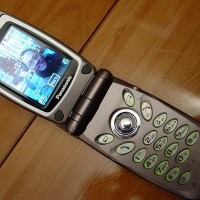Well, I have been switching phones quite actively with all the new models coming out. I have to admit, I had a lot of fun with the camera function of the Nokia 7650. The 7210 is a decent phone (though the new 6100 may just be better, especially at its price), but without the camera function, it just wasn’t as fun. The mobile phones in Japan have had all of the functionality built into a normal flip phone for sometime now. But none of those models have been available for the GSM market, until now.
The Panasonic GD88 (the same as the GD87, as its called in Europe, from what I can see) is the first. It takes a very basic flip format mobile phone, and places a camera and a large color screen into a small, light, GSM product. Just what I wanted.
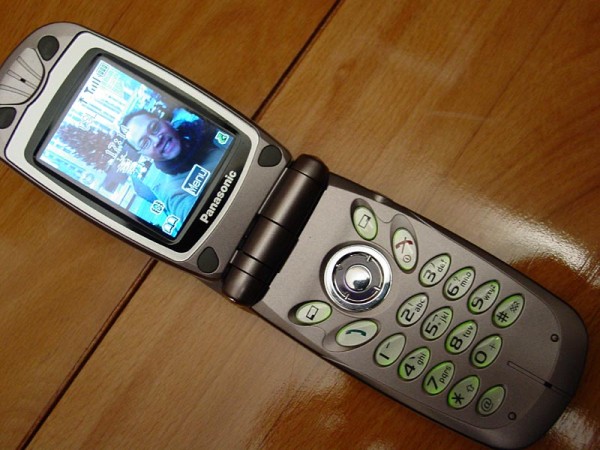
Panasonic GD88 Mobile Phone
Form
For all purposes, the GD88 is a flip phone that doesn’t try to radically change too much in design or form. It is a very basic design that Panasonic and others have been using for years in Japan. It just took a lot longer to get here. I like the very basic silver/chrome color. Sometimes simple works. At 103 grams, this phone is very light and is much thinner than the Nokia 7650.
The most impressive thing about the GD88 has to be the color screen. Without a doubt, this is the brightest, most brilliant screen I have seen on a GSM phone. If you flip open the phone in a dark theatre, it will more than illuminate you. It can probably be used as a flashlight in the dark! The Nokia 7650 was good too, but this one is way brighter and sharper. It is probably about as large as the 7650 screen that is perfect for pictures, texting, etc. Absolutely stunning.
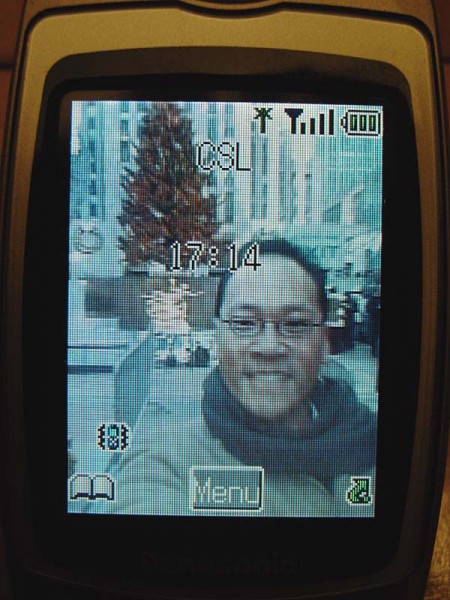
Panasonic GD88 Mobile Phone screen
The buttons are very typical, nothing new or fancy. But the bi-directional keypad is a bit different. It is very similar to the joystick like functions of the Nokia 7650 pointing device except that this one is more of a keypad than a separate pointing device. Nevertheless, it works well.
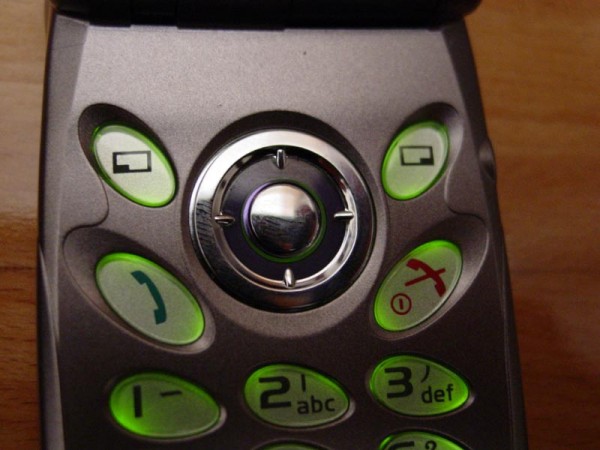
Panasonic GD88 Mobile Phone keypad
Another minor, but impressive new feature is the small screen on the outside. You can see the number of the calling party (assuming they allow caller ID) without having to flip open the phone first. Older flip phones from Motorola did not have this screen although I should add that newer models from Samsung and others have. Still I think it’s a good thing. More importantly, you have the ability to change the background color of the small screen on the outside, which illuminates depending on the situation (i.e. different ringing, message received, etc.) This just adds to how much better you can make the phone look depending on your own personal taste. I like this kind of control.
The one big downside to the GD88 that I can’t seem to understand why it still has an antennae that bulges out at the top. With the newer phones in Japan, and certainly with almost all of the Nokia phones, the absence of the antennae has become a prerequisite to design. Not only does it look awful, it also gets in the way when placed in pockets, etc.
Function
As a phone, the GD88 works extremely well. Panasonic is no slouch in terms of technology. The menus are intuitive, although they can get very detailed and sometimes confusing. Certainly, moving from a Nokia phone means that the new menus take some getting use to. But for the most part, they are easy to use and are user-friendly. I don’t think most people will have any problems with the phone. One thing though that I would say about the menus is that it’s sometimes a bit slow to respond, especially if you are doing something like opening a picture. The Nokia 7650 was much faster.
One of the big highlights about the GD88 is that it is a GSM tri-band phone. That means that it works in all GSM markets including the US. On my recent trip through the US, I was able to use the GPRS features on the AT&T network to send e-mail through the phone. This makes the GD88 the first tri-band phone with a built-in camera.
The GPRS/MMS function works well especially with the camera. I did have some initial problems with the setup and had to take the phone to my provider to get all the settings right. But once that’s done, the GD88 flies.
A camera function adds a great deal of fun to any mobile phone. Sending pictures around to other people, either through MMS or e-mail can get addictive. The fun part about the GD88 camera is that it has incorporated one neat function in that you can take a picture of yourself. Underneath the lens is a mini mirror that you can see your reflection so you can take pictures of yourself.
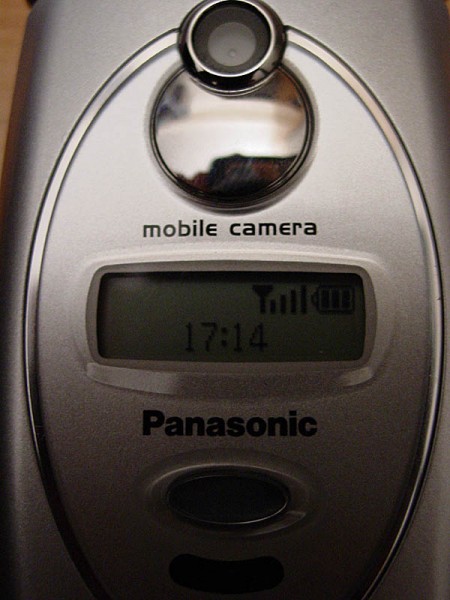
Panasonic GD88 Mobile Phone front
The downside of the camera though is that it does not take nearly as good pictures as the Nokia. You have to have a fairly steady hand to take most pictures or else you often get blurred images. Side-by-side, at the highest JPG resolution, the Nokia images came out better. On the other hand though, in the twilight/night mode, the GD88 takes much better night/dark pictures than the 7650. We took several images at a club and found the GD88 much better than the 7650 using the “twilight/night” modes on both cameras.
The most annoying thing with the camera though is the sound it makes when taking a picture. It’s an artificial like “click” that mimics the sound of a camera. The irritating factor is that no matter what setting you have it on (even on silent), you cannot turn this sound off. Perhaps there are some reasons why this sound should be left on, but more than often it’s just annoying. Most of the time though, like in a club, you won’t be able to hear it.
You do only get 1Mb of memory space which is a bit scarce, especially compared to the Nokia’s 4MB on the 7650. Images on the GD88 are recorded as the date and time at which the picture was taken (i.e. 12251530.jpg, meaning the picture was taken at 3:30PM on Dec. 25), which I found much more user friendly than the 7650 which just recorded each picture as Image (01), etc. This makes it much easier to find the picture you want.
However, the Nokia 7650 avoided this entire problem by having the one feature that I miss on the GD88 – thumbnails. On the 7650, you saw thumbnails of all the pictures so you could primarily ignore the file names. The GD88 does not show you thumbnails, so you’ll need to rely on the file names.
The GD88 uses a polyphonic speaker that means cool sounding ringtones. It also means that with the new speaker, the GD88 has a speakerphone function, a function I have come to like. The sound though is not as loud as you need it to be for a speakerphone, and with the speaker on the bottom of the phone, it’s hard to hear anyone unless you’re in an absolutely quiet environment. It’s better than the 7650 in terms of loudness, but is not nearly as good as the 7210 which is great as a speakerphone.
The GD88 has all the other usual functions that I have gotten used to on a mobile phone, like a calculator, date, alarm, etc. There is even a voice memo function on the GD88 that will allow you to record yourself. Pretty neat though not very useful for me, especially since its limited to 14 second recordings. I was fairly disappointed that there was only one game provided. A pathetic game called Herding Sheep. I would have preferred a Galaga or even Space Invaders. I will need to look into downloading other games that I know are available for Japanese handsets. The one missing function is of course bluetooth. Though I didn’t use it very often in other handsets, it was nice to have it as an option. I guess you can’t have it all.
With its super bright screen and all of the functions, there comes one potential downside… battery life. The battery has 720 mAh of power, which is relatively decent given its slim profile. Battery life is a concern here though because some people may be used to going days without having charge the phone. It’s not an issue for me though because I charge my phone every night anyways. I ran my battery down to one bar (the battery indicator has 3 bars to indicate it’s strength) in a day of playing with the camera, MMS, GPRS, game, etc. But, I have to admit, that I was really using the phone to the max.
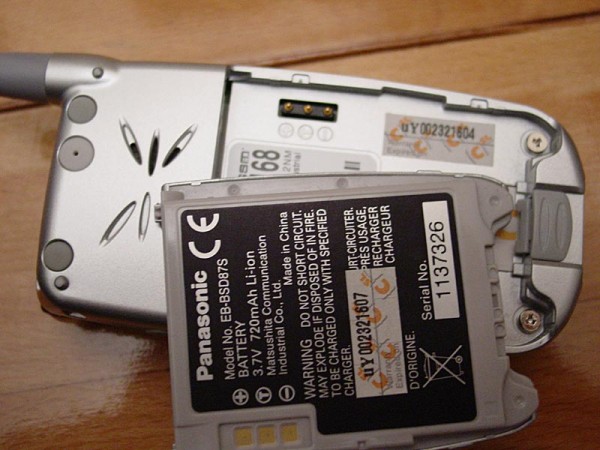
Panasonic GD88 Mobile Phone battery
In the real world, I don’t think this phone will run out of battery for at the very least, a day and a half of normal usage (predominantly voice-calls), maybe even two full days. But if you use all the other functions, you’ll likely need to charge the GD88 every day or risk the phone running out on you the next day. You can’t blame Panasonic though because if the battery had more capacity, the phone would definitely have been heavier and more bulky.
The phone comes with one of the smallest boxes, primarily because it comes with nothing other than the phone, battery, charger and the instruction manual. No earphone piece (you have to buy it separately), case, or any other goodies. Given the price you are you paying, this is pretty disappointing.
Factor
At the end of the day, this is by far the best phone available right now in my opinion. How long it can keep that esteemed status remains to be seem. The Sony Ericsson P800 is somewhere in the very near future (though the demo model I saw was much bigger than I expected so the GD88 may still have an edge). But other models from Sharp and Nokia (like the pretty cool looking 3650 that they have been showing around with its built-in video recorder) are just around the corner too. The one major factor working against this phone is the price. Even at my discount prices, I still had to pay US$750 for the phone. I’m sure prices have dropped, and I did see it for around US$600 (and probably falling) though I don’t know if this came with some conditions.
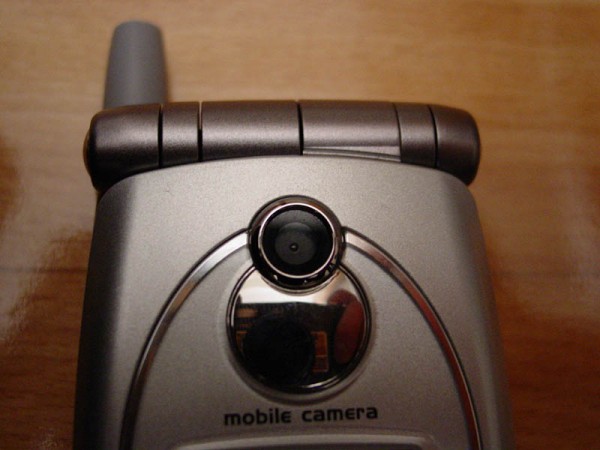
Panasonic GD88 Mobile Phone camera
For what you get, this phone is an ESSENTIAL buy, but maybe only for now. Despite the price (which almost made this a MONEY TO BURN type of gadget), I have really come to enjoy using and playing with this phone and all of the functions. With all the new phones coming out, you would be wise to wait a few weeks if not months before you buy the GD88 as the price is likely to drop, not to mention that it will be facing some pretty stiff competition from newer models. As expected, I may end up buying other phones, like the P800 if it comes out at a reasonable price. But for now, the GD88 is a winner in my books.
